
|

|
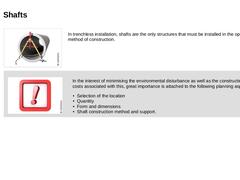
|

| (Image: Planning) In trenchless installation, shafts are the only structures that must be installed in the open-cut method of construction. | | (Image: Attention!) | In the interest of minimising the environmental disturbance as well as the construction costs associated with this, great importance is attached to the following planning aspects: - Selection of the location
- Quantity
- Form and dimensions
- Shaft construction method and support.
|
|
|
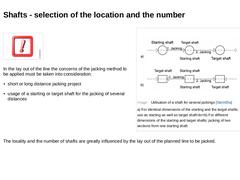
|

(Image: Attention!) In the lay out of the line the concerns of the jacking method to be applied must be taken into consideration: (Image: Utilisation of a shaft for several jackings [Stein05a]) The locality and the number of shafts are greatly influenced by the lay out of the planned line to be jacked. |
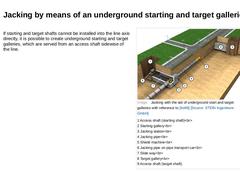
|

If starting and target shafts cannot be installed into the line axis directly, it is possible to create underground starting and target galleries, which are served from an access shaft sidewise of the line. (Image: Jacking with the aid of underground start and target galleries with reference to [Ito98] [Image: S&P GmbH]) |

|

The shape and dimensions of shafts should be planned and built under the aspect of minimising expected emissions and construction costs as well as work and health protection. |
(Image: Cross sectional shapes of starting and target shafts) |
|
(Image: Attention!)
Shafts in which work is carried out must have sufficient working space. The dimensions of the working space depend on the slope angle, lining, equipment, type of pipe and method of working [… |
|
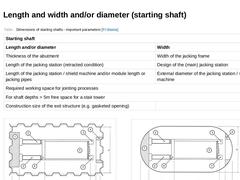
|

(Table: Dimensions of starting shafts - important parameters [FI-Steina]) | | (Image: Starting shaft dimensions for jacking pipes of 2.43 m lenght for rectangular shape of shaft and sheet pile wall lining for pre-defined microtunnelling or shield machine and jacking station [FI-Toyot])
| (Image: Starting shaft dimensions for jacking pipes of 2.43 m lenght for rectangular shape of shaft with semi-circular rounded faces and lining of liner plates for pre-… |
|

|

(Table: Dimensions of target shafts - important parameters [FI-Steina]) | | (Image: Target shaft dimensions for square shape of shaft and sheet pile wall lining for pre-defined microtunnelling or shield machine and jacking station [FI-Toyot])
| (Image: Target shaft dimensions for circular shape of shaft and lining with liner plates for pre-defined microtunnelling or shield machine and jacking station [FI-Toyot])
|
|
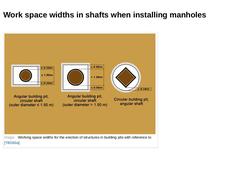
|

(Image: Working space widths for the erection of structures in building pits with reference to [TBG93a]) |
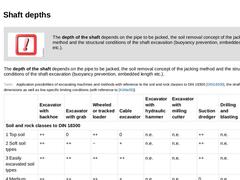
|

|
(Image: Attention!)
The depth of the shaft depends on the pipe to be jacked, the soil removal concept of the jacking method and the structural conditions of the shaft excavation (buoyancy prevention, embedded length etc.). |
|
The depth of the shaft depends on the pipe to be jacked, the soil removal concept of the jacking method and the structural conditions of the shaft excavation (buoyancy prevention, embedded length etc.). |
|
(Table: Application possibilities … |
|
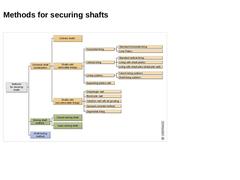
|

(Image: Methods for securing shafts [Stein05a]) |
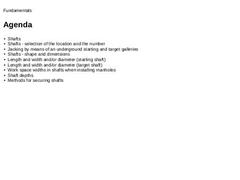
|

|
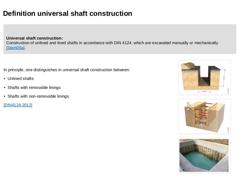
|

Universal shaft construction:
Construction of unlined and lined shafts in accordance with DIN 4124, which are excavated manually or mechanically [Stein05a]. |
In principle, one distinguishes in universal shaft construction between: [DIN4124:2012] |
|
(Image: Securing of trenches and shafts without lining with reference to [DIN4124c] - Vertical sloped walls) |
|
(Image: Standard … |
|
|
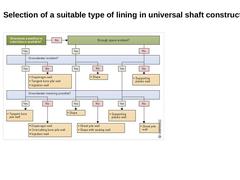
|

(Image: Diagram for the selection of a suitable lining type in universal shaft construction) |
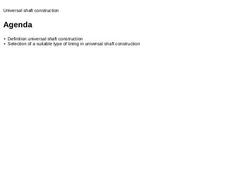
|

|
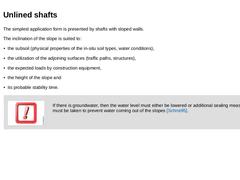
|

The simplest application form is presented by shafts with sloped walls. The inclination of the slope is suited to: -
the subsoil (physical properties of the in-situ soil types, water conditions),
-
the utilization of the adjoining surfaces (traffic paths, structures),
-
the expected loads by construction equipment,
-
the height of the slope and
-
its probable stability time.
|
(Image: Attention!)
If there is groundwater, then the water level must either … |
|
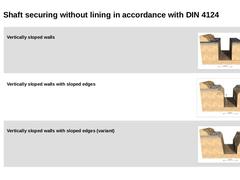
|

| (Image: Securing of trenches and shafts without lining with reference to [DIN4124c] - Vertical sloped walls)
Vertically sloped walls | | (Image: Securing of trenches and shafts without lining with reference to [DIN4124c] - Vertical sloped walls with sloped edges)
Vertically sloped walls with sloped edges | | (Image: Securing of trenches and shafts without lining with reference to [DIN4124c] - Vertical sloped walls with sloped edges (variant))
Vertically … |
|
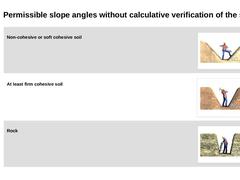
|

| (Image: Permissible slope angles for trenches and shafts for non-cohesive or soft cohesive soils with reference to [DIN4124c] [Image: S&P GmbH])
Non-cohesive or soft cohesive soil | | (Image: Permissible slope angles for trenches and shafts for at least firm cohesive soils with reference to [DIN4124c] [Image: S&P GmbH])
At least firm cohesive soil | | (Image: Permissible slope angles for trenches and shafts for rock with reference to [DIN4124c] [Image: … |
|
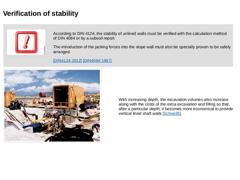
|

|
(Image: Attention!)
According to DIN 4124, the stability of unlined walls must be verified with the calculation method of DIN 4084 or by a subsoil report. The introduction of the jacking forces into the slope wall must also be specially proven to be safely arranged. [DIN4124:2012] [DIN4084:1997] |
|
(Image: Unlined, sloped starting shafts - In microtunnelling with hydraulic spoil removal [FI-Herreb]) |
With increasing depth, the excavation volumes … |
|
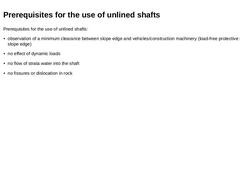
|

Prerequisites for the use of unlined shafts: -
observation of a minimum clearance between slope edge and vehicles/construction machinery (load-free protective strip at the slope edge)
-
no effect of dynamic loads
-
no flow of strata water into the shaft
-
no fissures or dislocation in rock
|
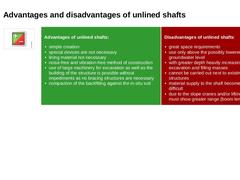
|

| (Image: Pros and cons) |
Advantages of unlined shafts: - simple creation
- special devices are not necessary
- lining material not necessary
- noise-free and vibration-free method of construction
- use of large machinery for excavation as well as the building of the structure is possible without impediments as no bracing structures are necessary
- compaction of the backfilling against the in-situ soil
|
Disadvantages of unlined shafts: - great space requirements…
|
|
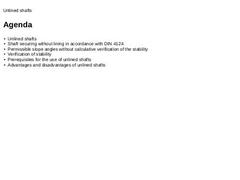
|

|
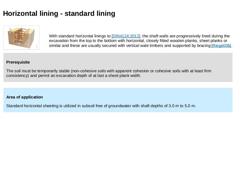
|

|
(Image: Standard horizontal lining to DIN 4124 (means of fixing not shown) with reference to [DIN4124c] [Image: S&P GmbH]) |
With standard horizontal linings to [DIN4124:2012], the shaft walls are progressively lined during the excavation from the top to the bottom with horizontal, closely fitted wooden planks, sheet planks or similar and these are usually secured with vertical wale timbers and supported by bracing [Riege00b]. |
|
|
Prerequisite The … |
|
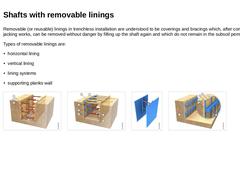
|

Removable (or reusable) linings in trenchless installation are understood to be coverings and bracings which, after completion of the jacking works, can be removed without danger by filling up the shaft again and which do not remain in the subsoil permanently. Types of removable linings are: -
horizontal lining
-
vertical lining
-
lining systems
-
supporting planks wall
(Image: Standard horizontal lining to DIN 4124 (means of fixing not shown) with reference … |
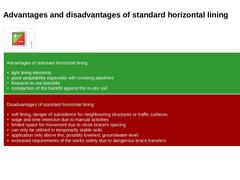
|

| (Image: Pros and cons) | | Advantages of standard horizontal lining: - light lining elements
- good adaptability especially with crossing pipelines
- frequent re-use possible
- compaction of the backfill against the in-situ soil
| | Disadvantages of standard horizontal lining: - soft lining, danger of subsidence for neighbouring structures or traffic surfaces
- wage and time intensive due to manual activities
- limited space for movement due to close bracers spacing…
|
|
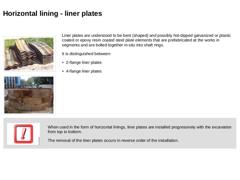
|

|
(Image: Shaft supporting based on 2-flange liner plates using as an example the products of the HAMCO company [FI-Hamco] - View) (Image: Shaft supporting based on 4-flange liner plates ) |
Liner plates are understood to be bent (shaped) and possibly hot-dipped galvanized or plastic coated or epoxy resin coated steel plate elements that are prefabricated at the works in segments and are bolted together in-situ into shaft rings. It is distinguished between: |
|